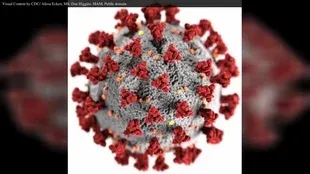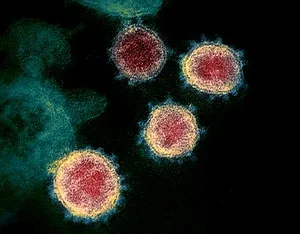Coronavirus disease 2019 (COVID-19) is an infectious disease caused by severe acute respiratory syndrome coronavirus 2 (SARS-CoV-2). It was first identified in December 2019 in Wuhan, China, and has resulted in an ongoing pandemic. The first confirmed case has been traced back to 17 November 2019. Traces of the virus have been found in December-2019 wastewater that was collected from Milan and Turin. As of 22 June 2020, more than 9 million cases have been reported across 188 countries and territories, resulting in more than 469,000 deaths. More than 4.46 million people have recovered.
Common symptoms include fever, cough, fatigue, shortness of breath, and loss of smell and taste. While the majority of cases result in mild symptoms, some progress to acute respiratory distress syndrome (ARDS) possibly precipitated by cytokine storm, multi-organ failure, septic shock, and blood clots. The time from exposure to onset of symptoms is typically around five days, but may range from two to fourteen days.
The virus is primarily spread between people during close contact, most often via small droplets produced by coughing, sneezing, and talking. The droplets usually fall to the ground or onto surfaces rather than travelling through air over long distances. However, research as of June 2020 has shown that speech-generated droplets may remain airborne for tens of minutes. Less commonly, people may become infected by touching a contaminated surface and then touching their face. It is most contagious during the first three days after the onset of symptoms, although spread is possible before symptoms appear, and from people who do not show symptoms. The standard method of diagnosis is by real-time reverse transcription polymerase chain reaction (rRT-PCR) from a nasopharyngeal swab. Chest CT imaging may also be helpful for diagnosis in individuals where there is a high suspicion of infection based on symptoms and risk factors; however, guidelines do not recommend using CT imaging for routine screening.
Recommended measures to prevent infection include frequent hand washing, maintaining physical distance from others (especially from those with symptoms), quarantine (especially for those with symptoms), covering coughs, and keeping unwashed hands away from the face. The use of cloth face coverings such as a scarf or a bandana has been recommended by health officials in public settings to minimise the risk of transmissions, with some authorities requiring their use. Health officials also stated that medical-grade face masks, such as N95 masks, should only be used by healthcare workers, first responders, and those who directly care for infected individuals.
According to the World Health Organization (WHO), there are no vaccines nor specific antiviral treatments for COVID-19. Management involves the treatment of symptoms, supportive care, isolation, and experimental measures. The World Health Organization (WHO) declared the COVID‑19 outbreak a public health emergency of international concern (PHEIC) on 30 January 2020 and a pandemic on 11 March 2020. Local transmission of the disease has occurred in most countries across all six WHO regions.
Fever is the most common symptom of COVID-19, but is highly variable in severity and presentation, with some older, immunocompromised, or critically ill people not having fever at all. In one study, only 44% of people had fever when they presented to the hospital, while 89% went on to develop fever at some point during their hospitalization. A lack of fever does not verify someone is disease free.
COVID-19 spreads primarily when people are in close contact and one person inhales small droplets produced by an infected person (symptomatic or not) coughing, sneezing, talking, or singing. The WHO recommends 1 metre (3 ft) of social distance; the U.S. CDC recommends 2 metres (6 ft). People can transmit the virus without showing symptoms, but it is unclear how often this happens. One estimate of the number of those infected who are asymptomatic is 40%.
People are most infectious when they show symptoms (even mild or non-specific symptoms), but may be infectious for up to two days before symptoms appear (pre-symptomatic transmission). They remain infectious an estimated seven to twelve days in moderate cases and an average of two weeks in severe cases.
Preventive measures to reduce the chances of infection include staying at home, avoiding crowded places, keeping distance from others, washing hands with soap and water often and for at least 20 seconds, practising good respiratory hygiene, and avoiding touching the eyes, nose, or mouth with unwashed hands. The U.S. Centers for Disease Control and Prevention (CDC) recommends covering the mouth and nose with a tissue when coughing or sneezing and recommends using the inside of the elbow if no tissue is available. Proper hand hygiene after any cough or sneeze is encouraged. The CDC has recommended cloth face coverings in public settings where other social distancing measures are difficult to maintain, in part to limit transmission by asymptomatic individuals. The U.S. National Institutes of Health guidelines do not recommend any medication for prevention of COVID‑19, before or after exposure to the SARS-CoV-2 virus, outside the setting of a clinical trial.
No medication or vaccine is approved with the specific indication to treat the disease. International research on vaccines and medicines in COVID‑19 is underway by government organisations, academic groups, and industry researchers. In March, the World Health Organisation initiated the "Solidarity Trial" to assess the treatment effects of four existing antiviral compounds with the most promise of efficacy. The World Health Organization suspended hydroxychloroquine from its global drug trials for COVID-19 treatments on 26 May 2020 due to safety concerns. It had previously enrolled 3,500 patients from 17 countries in the Solidarity Trial. France, Italy and Belgium also banned the use of


hydroxychloroquine as a COVID-19 treatment